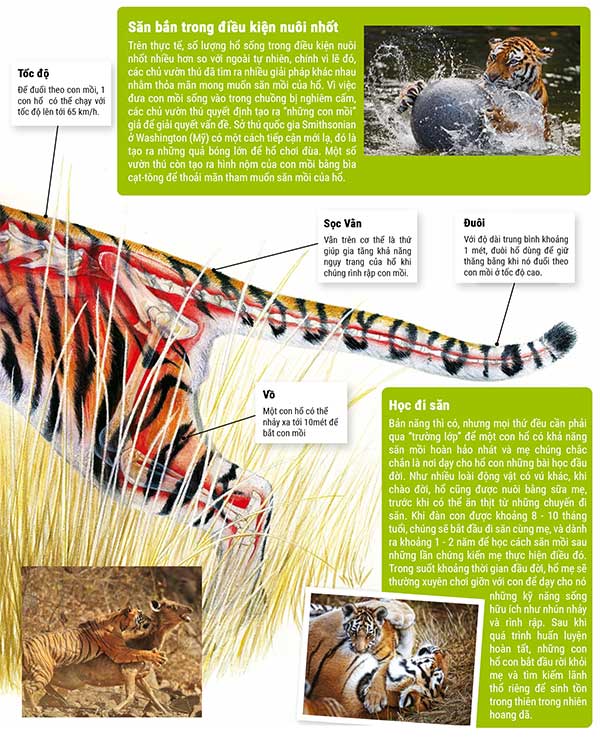How are predatory tigers?
These big "cats" can take down their prey without any help from their kind. Nestled in the prairie grasslands, a large cat is crouching like a compressed spring, ready to fly up to grab any bad prey that passes by. In a split second, this killer cat leaps out of hiding, inflicting a fatal blow on the back of the prey before eating it.
Tigers are considered to be the infamous stalkers, a natural skill to help them survive in harsh nature. Usually, hunting like this will take place once a week, and on average they can consume 40kg of food in one meal. With an almost complete diet of meat and sophisticated hunting skills , tigers deserve to be at the top of the food chain.


Estimates show that the most appropriate range for tigers to grab prey is about 6-9 meters. When the prey is in this area, the tiger will aim at its neck, then fly to grab it to cut off the ill-fated animal's spinal cord. With available swimming ability, tigers can fully utilize the nearby water to submerge their prey.
Often prey at night, tigers have excellent visual acuity - 6 times more than human night vision. Unlike lions, tigers do not prey on herds but prefer to do it alone. Although this behavior reduces the success rate in each hunt, if successful, the reward is of course reserved for the winner.
Factors that make up the tiger's amazing hunting ability:
Sight
There is a habit of hunting at night, so the tiger possesses excellent visual ability that makes it easy to detect prey movements even in the dark.
Hearing
A tiger is able to hear sounds at frequencies up to 300-500Hz, along with ultrasound at low frequencies that the human ear cannot hear.
Claws
With the ability to collect when not needed, tiger nails are up to 10cm long.
Teeth
Nearly 8cm long, the tiger possesses the largest fangs in the cat family. Each tiger's mouth has up to 30 sharp teeth, with a bite force of more than 1,000 PSI, five times the bite of humans.
Speed
To chase prey, a tiger can run at speeds of up to 65 km / h.
Stripes
Stripes on the body are things that increase tiger's ability to camouflage when they stalk their prey. Similar to human fingerprints, stripes on each tiger's body are unique and none of them look like any other
Tail
With an average length of about 1 meter, the tiger's tail is used for balance when it chases prey at high speed.
Maul
A tiger can jump as far as ten meters to catch prey
Hunting in captivity
In fact, the number of tigers living in captivity is much higher than in the wild, for that reason, zoo owners have found many different solutions to satisfy the tiger's desire to hunt.
Because bringing live prey into the barn is strictly prohibited, zoo owners decided to create fake 'prey' to solve the problem. The Smithsonian National Zoo in Washington (USA) has a novel approach, which is to create big balls for tigers to play. Some of the zoos also created the effigy of prey with cardboard cover to satisfy the tiger's desire to hunt.
Learn to hunt
Instinct is there, but everything needs to go through the 'school' so that a tiger with perfect hunting skills and their mother is definitely a place to teach tigers early life lessons. Like many other mammals, when born, tigers are also fed with breast milk, before they can eat meat from hunting trips.
When the cubs are about 8-10 months old, they will start hunting with their mothers, and spend about 1-2 years learning how to hunt after seeing their mother do it. During the first period of life, the mother tiger will often play around with her to teach her useful life skills such as swinging and stalking. After the training process is complete, the cubs begin to leave their mother and seek their own territory to survive in the wild.
- The Lord of the Forest is around the world
- Legend of the tiger tiger U Minh
- The magnificent, magnificent tiger pictures of Siberia
- Fear for tigers in the year of tiger
- Four white tigers gave birth to four
- The United Nations is concerned about the survival of tigers
- Interesting: Goat raising tigers
- The number of tigers decreased rapidly
- Introducing the world's largest tiger and tiger
- Magical friendship between tigers and pigs
- The news that Tasmanian tigers became extinct 80 years ago appeared in Australia
- 12 interesting facts about tigers that amaze you
 Animal 'suffering' after hibernation
Animal 'suffering' after hibernation Why do goats climb well?
Why do goats climb well? Scientists were surprised to see chimpanzees eating turtles
Scientists were surprised to see chimpanzees eating turtles Giant catfish died deadly due to drought in Thailand
Giant catfish died deadly due to drought in Thailand